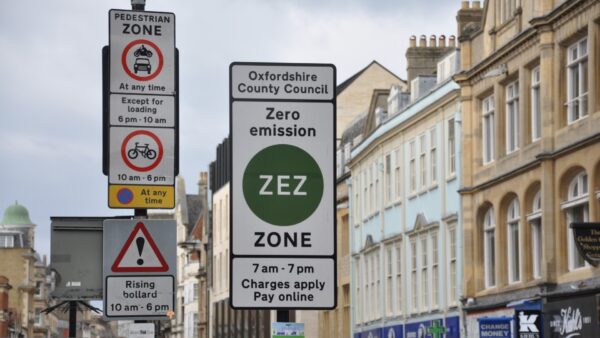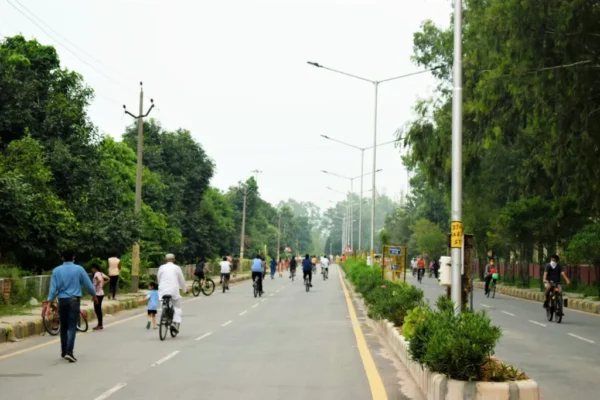Did you know that nearly 1.8 crore people in Delhi are on track to lose 11.9 years of life expectancy due to degrading air quality? As India grapples with the escalating crisis of air pollution, especially during the winter months, cities like Delhi, Kolkata, and Mumbai end up suffocating under a thick blanket of pollution. Traditional solutions have fallen short as emissions from vehicles, industries, and urban sprawl continue to rise, leaving policymakers in a bind. With the first Global Stocktake from COP28 affirming that we are falling short of the 1.5°C climate target, it is crucial to rethink how we tackle air pollution.
Instead of relying solely on traditional regulatory measures, there is an opportunity to enhance the implementation of innovative strategies such as Low Emission Zones (LEZs) and Zero Emission Zones (ZEZs). These could serve as game-changers for Indian cities, paving the way for a cleaner and healthier urban future.
Improving air quality: What are low and zero-emission zones?
Low Emission Zones (LEZs) are designated areas within cities that limit access for the most polluting vehicles, while Zero-Emission Zones (ZEZs) take this a step further by completely barring polluting vehicles from entering. Only zero-emission vehicles, such as electric cars and trucks, as well as pedestrians and cyclists, are given free access. These zones offer cities a way to experiment with new approaches to urban mobility by prioritizing walking, cycling, and public transport, while also boosting the use of zero-emission vehicles and actively involving residents in the process of creating cleaner and more sustainable urban environments.
Case Studies in Action
- UK – ZEZ: Launched in February 2022, Oxford’s Zero Emission Zone covers a portion of the city center, with plans for a wider zone based on the pilot’s results. Zero-emission vehicles can drive freely, while petrol and diesel vehicles are charged a daily fee between 7am and 7pm, with some discounts and exemptions available. This ZEZ is expected to generate £1.8 million by the time the pilot ends in 2026. The Oxford ZEZ charge ranges from £2 to £10 (approx. ₹220 to ₹1100) until August 2025, after which it is expected to double.

- France – Paris LEZ: Paris currently operates a LEZ and has set a timeline to transition it to a ZEZ by 2030 to enhance local air quality. The existing LEZ covers 79 municipalities within the Greater Paris Metropolis and applies to all vehicle categories. For buses, coaches, and heavy-duty trucks, the LEZ operates daily from 8 AM to 8 PM, while other vehicles are restricted during the same hours on weekdays only. Access to the zone is determined by the Crit’Air air quality certificate, a sticker displayed on vehicles. Non-compliant buses, coaches, and heavy-duty trucks entering the zone incur a penalty of €135 (approx. ₹12,444), while all other non-compliant vehicles are charged €68 (approx. ₹6,268).
- Netherlands – National Framework: The Netherlands has established a national framework for LEZs, known as milieuzone, promoting cleaner air in urban centers. This framework sets clear guidelines for cities to implement LEZs, reflecting a commitment to combating vehicular pollution and improving public health.
- India – Kewadia ZEZ: In June 2021, India announced the development of its first electric vehicles-only zone in Kewadia, Gujarat. This initiative, led by the Statue of Unity Area Development and Tourism Governance Authority (SOUADTGA), aims to replace petrol and diesel vehicles with electric ones in the region. It restricts vehicle access around the Statue of Unity, with visitors required to park internal combustion engine vehicles in designated lots and use shared electric three-wheelers and buses to move around. This initiative not only promotes sustainable tourism but also sets a precedent for zero-emission zones across the country.
The Path Forward for India
While Kewadia’s ZEZ marks a promising start, there exists significant potential to expand these efforts across the country. Indian cities, particularly those grappling with severe air pollution like Delhi, Mumbai, and Kolkata, stand to benefit from rapid and more widespread implementation of LEZs and the introduction of ZEZs in highly polluted areas. As cities like Delhi have begun adopting LEZs under the Graded Response Action Plan (GRAP) to discourage older, more polluting vehicles, there is an urgent need for stricter enforcement and an expanded reach of these zones. Alongside the introduction of ZEZs, these measures can play a pivotal role in significantly reducing vehicular emissions.
To guide this transition, a 2023 report by International Council on Clean Transportation has identified five pathways through which it is possible to expand as well as introduce LEZs and ZEZs in India. The first pathway involves the central government directly designating specific cities as LEZs and ZEZs. Following this, the second pathway includes establishing a national program for LEZs and ZEZs, requiring state governments to collaborate with cities to plan and implement these zones.
Additionally, the third pathway allows state governments to designate certain cities or regions as air pollution control areas. The fourth pathway gives state governments the authority to enable cities to impose restrictions on polluting vehicles under the Central Motor Vehicle Act. Lastly, the fifth pathway empowers municipal corporations to independently plan and implement LEZs and ZEZs without needing mandates from state or national authorities.
Ultimately, the transition to Low and Zero-Emission Zones presents a vital opportunity for Indian cities to reclaim their air quality and to enhance the quality of life for their residents. By drawing insights from successful implementations in countries like the UK, France, and the Netherlands, and leveraging frameworks like the GRAP and the National Clean Air Programme (NCAP), India can create a roadmap for cleaner air. Implementing these innovative zones not only addresses air pollution effectively but also catalyzes a broader transformation in urban mobility, setting the stage for sustainable development and healthier living environments across the nation.

